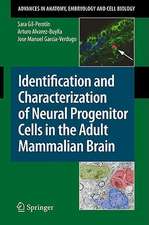Stem Cell-Based Neural Model Systems for Brain Disorders: Methods in Molecular Biology, cartea 2683
Editat de Yu-Wen Alvin Huang, ChangHui Paken Limba Engleză Hardback – 11 iun 2023
Authoritative and practical, Stem Cell-Based Neural Model Systems for Brain Disorders serves as an essential resource for researchers and students in neuroscience, stem cell biology, and related fields.
Din seria Methods in Molecular Biology
- 9%
 Preț: 791.63 lei
Preț: 791.63 lei - 23%
 Preț: 598.58 lei
Preț: 598.58 lei - 20%
 Preț: 882.98 lei
Preț: 882.98 lei -
 Preț: 252.05 lei
Preț: 252.05 lei - 5%
 Preț: 802.70 lei
Preț: 802.70 lei - 5%
 Preț: 729.61 lei
Preț: 729.61 lei - 5%
 Preț: 731.43 lei
Preț: 731.43 lei - 5%
 Preț: 741.30 lei
Preț: 741.30 lei - 5%
 Preț: 747.16 lei
Preț: 747.16 lei - 15%
 Preț: 663.45 lei
Preț: 663.45 lei - 18%
 Preț: 1025.34 lei
Preț: 1025.34 lei - 5%
 Preț: 734.57 lei
Preț: 734.57 lei - 18%
 Preț: 914.20 lei
Preț: 914.20 lei - 15%
 Preț: 664.61 lei
Preț: 664.61 lei - 15%
 Preț: 654.12 lei
Preț: 654.12 lei - 18%
 Preț: 1414.74 lei
Preț: 1414.74 lei - 5%
 Preț: 742.60 lei
Preț: 742.60 lei - 20%
 Preț: 821.65 lei
Preț: 821.65 lei - 18%
 Preț: 972.30 lei
Preț: 972.30 lei - 15%
 Preț: 660.49 lei
Preț: 660.49 lei - 5%
 Preț: 738.41 lei
Preț: 738.41 lei - 18%
 Preț: 984.92 lei
Preț: 984.92 lei - 5%
 Preț: 733.29 lei
Preț: 733.29 lei -
 Preț: 392.60 lei
Preț: 392.60 lei - 5%
 Preț: 746.26 lei
Preț: 746.26 lei - 18%
 Preț: 962.66 lei
Preț: 962.66 lei - 23%
 Preț: 860.22 lei
Preț: 860.22 lei - 15%
 Preț: 652.64 lei
Preț: 652.64 lei - 5%
 Preț: 1055.50 lei
Preț: 1055.50 lei - 23%
 Preț: 883.87 lei
Preț: 883.87 lei - 5%
 Preț: 1141.13 lei
Preț: 1141.13 lei - 19%
 Preț: 491.89 lei
Preț: 491.89 lei - 5%
 Preț: 1038.86 lei
Preț: 1038.86 lei - 5%
 Preț: 524.16 lei
Preț: 524.16 lei - 18%
 Preț: 2122.34 lei
Preț: 2122.34 lei - 5%
 Preț: 1299.23 lei
Preț: 1299.23 lei - 5%
 Preț: 1339.12 lei
Preț: 1339.12 lei - 18%
 Preț: 1390.26 lei
Preț: 1390.26 lei - 18%
 Preț: 1395.63 lei
Preț: 1395.63 lei - 18%
 Preț: 1129.65 lei
Preț: 1129.65 lei - 18%
 Preț: 1408.26 lei
Preț: 1408.26 lei - 18%
 Preț: 1124.92 lei
Preț: 1124.92 lei - 18%
 Preț: 966.27 lei
Preț: 966.27 lei - 5%
 Preț: 1299.99 lei
Preț: 1299.99 lei - 5%
 Preț: 1108.51 lei
Preț: 1108.51 lei - 5%
 Preț: 983.76 lei
Preț: 983.76 lei - 5%
 Preț: 728.16 lei
Preț: 728.16 lei - 18%
 Preț: 1118.62 lei
Preț: 1118.62 lei - 18%
 Preț: 955.25 lei
Preț: 955.25 lei - 5%
 Preț: 1035.62 lei
Preț: 1035.62 lei
Preț: 1391.83 lei
Preț vechi: 1697.36 lei
-18% Nou
Puncte Express: 2088
Preț estimativ în valută:
266.36€ • 289.23$ • 223.74£
266.36€ • 289.23$ • 223.74£
Carte tipărită la comandă
Livrare economică 23 aprilie-07 mai
Preluare comenzi: 021 569.72.76
Specificații
ISBN-13: 9781071632864
ISBN-10: 1071632868
Pagini: 292
Ilustrații: XIII, 292 p. 1 illus.
Dimensiuni: 178 x 254 mm
Greutate: 0.75 kg
Ediția:2023
Editura: Springer Us
Colecția Humana
Seria Methods in Molecular Biology
Locul publicării:New York, NY, United States
ISBN-10: 1071632868
Pagini: 292
Ilustrații: XIII, 292 p. 1 illus.
Dimensiuni: 178 x 254 mm
Greutate: 0.75 kg
Ediția:2023
Editura: Springer Us
Colecția Humana
Seria Methods in Molecular Biology
Locul publicării:New York, NY, United States
Cuprins
Generation of Cerebral Cortical Neurons from Human Pluripotent Stem Cells in 3D Culture.- Generation of Homogeneous Populations of Cortical Interneurons from Human Pluripotent Stem Cells.- Generation and Co-Culture of Cortical Glutamatergic and GABAergic Induced Neuronal Cells.- Transcription Factor-Directed Dopaminergic Neuron Differentiation from Human Pluripotent Stem Cells.- Directed Differentiation of Human iPSCs into Microglia-Like Cells Using Defined Transcription Factors.- The Generation and Functional Characterization of Human Microglia-Like Cells Derived from iPS and Embryonic Stem Cells.- Modeling Cellular Crosstalk of Neuroinflammation Axis by Tri-Cultures of iPSC-Derived Human Microglia, Astrocytes, and Neurons.- Generation of Oligodendrocytes from Human Pluripotent and Embryonic Stem Cells.- Characterizing the Neuron-Glial Interactions by the Co-Cultures of Human iPSC-Derived Oligodendroglia and Neurons.- Defined Differentiation of Human Pluripotent Stem Cells to Brain Microvascular Endothelial-Like Cells for Modeling the Blood-Brain Barrier.- Modeling the Blood-Brain Barrier Using Human Induced Pluripotent Stem Cells.- A Three-Dimensional Primary Cortical Culture System Compatible with Transgenic Disease Models, Virally-Mediated Fluorescence, and Live Microscopy.- Method to Generate Dorsal Forebrain Brain Organoids from Human Pluripotent Stem Cells.- A 3D Bioengineered Neural Tissue Model Generated from Human iPSC-Derived Neural Precursor Cells.- FACS-Based Sequencing Approach to Evaluate Cell Type to Genotype Associations Using Cerebral Organoids.- Dynamic Measurement of Endosome-Lysosome Fusion in Neurons Using High-Content Imaging.- Live-Imaging Detection of Multivesicular Body-Plasma Membrane Fusion and Exosome Release in Cultured Primary Neurons.- Assays of Monitoring and Measuring Autophagic Flux for iPSC-Derived Human Neurons and Other Brain Cell Types.- Measuring Neuronal Network Activity Using Human Induced Neuronal Cells.- A Simple Ca2+-Imaging Approach of Network-Activity Analyses for Human Neurons.- Whole Cell Patch Clamp Electrophysiology in Human Neuronal Cells.- Assaying Chemical Long-Term Potentiation in Human iPSC-Derived Neuronal Networks.
Textul de pe ultima copertă
This detailed volume presents validated and well-adapted procedures involving humanized and/or stem cell-based neural model systems that have proven helpful in better understanding the essential brain functions involved in the pathogenesis of brain disorders. The book explores the generation of multiple neural cell types in 2D and 3D as well as cutting-edge techniques to assay neural function. Written for the highly successful Methods in Molecular Biology series, chapters include introductions to their respective topics, lists of the necessary materials and reagents, step-by-step and readily reproducible laboratory protocols, and tips on troubleshooting and avoiding known pitfalls.
Authoritative and practical, Stem Cell-Based Neural Model Systems for Brain Disorders serves as an essential resource for researchers and students in neuroscience, stem cell biology, and related fields.
Caracteristici
Includes cutting-edge techniques Provides step-by-step detail essential for reproducible results Contains key implementation advice from the experts


























